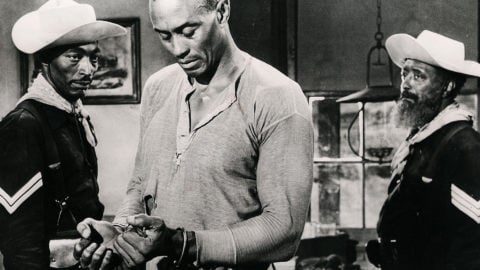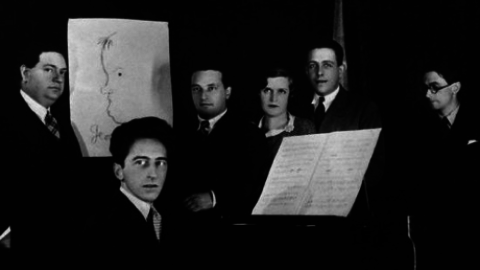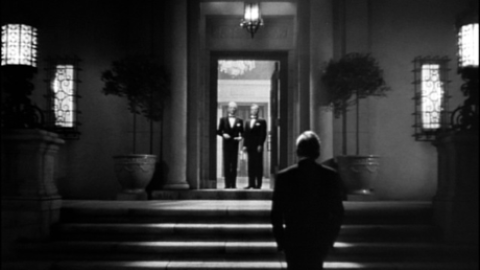Rep Diary: Ford and Ireland
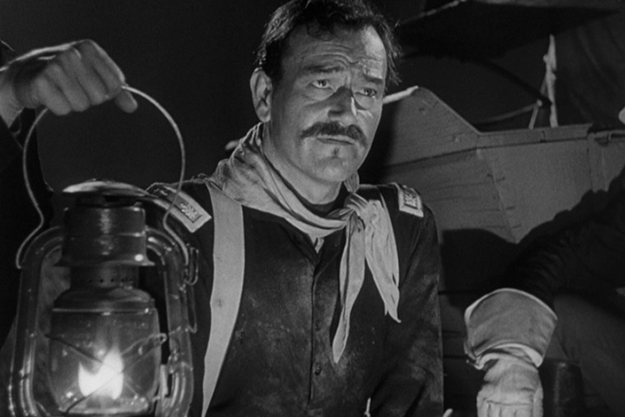
Rio Grande
An eerily suspended, time-stopping moment from a filmmaker particularly skilled at them: the cavalry regiment under the command of one Lt. Colonel Kirby Yorke (John Wayne), having set up camp overnight near the Texas border, settles down for a song. The high-ranking officers are visibly worn out. Even the indefatigable Sgt. Quincannon, the bull-necked Irish career soldier unforgettably embodied by Victor McLaglen, looks creased and furrowed around the face as he requests permission for the Sons of the Pioneers—a Western vocal act who furnished dozens of the era’s films with folk tunes and cowboy ballads—to sing. When they first appear on screen, it’s in a tight medium shot that shows them huddled intimately together around a single, bright-faced young singer. The opening lines of a song emerge from this man in a soft, rounded lilt:
’Twas down by the glenside, I met an old woman
A-plucking young nettles, she ne’er saw me coming
I listened a while to the song she was humming…
The group moves into the song’s funereal chorus—“Glory-O, Glory-O, to the bold Fenian men”—after a cut to a wide shot reveals them less huddled together than lined up, one by one, along the length of a wooden fence. As they move through two more verses, the high-ranking officers gathered in front of them find their faces loosening with emotion. Yorke’s younger wife (Maureen O’Hara), from whom he’s been separated for years since a wartime breach of loyalty, sends him a significant glance; Quincannon, in a climactic close-up, starts weeping. The song ends with a half-second pause and a curt “thank you, men.”
The film is Rio Grande, the 1950 Western that concluded John Ford’s cavalry trilogy. The song is “Down by the Glenside (The Bold Fenian Men),” and its inclusion in the movie is one of those half-private, talismanic gestures which fill the director’s work. Ford includes the song’s three most generally evocative verses in Rio Grande—mournful reminiscences of “strong manly forms” and “eyes with hope gleaming” that could refer just as well to cavalry officers as to any other men of war—and left out the two that identify it unambiguously as what it is: a rebel song written by Patrick Kearney in honor of the members of the Irish Republican Brotherhood who fought, and died, to free their country from British rule. Coming from the Sons of the Pioneers, the song’s third and fourth verses would sound jarringly out of place:
When I was a young girl, their marching and drilling
Awoke in the glenside sounds awesome and thrilling
They loved dear old Ireland, to die they were willing
Glory O, Glory O, to the bold Fenian men.
Some died by the glenside, some died near a stranger
And wise men have told us their cause was a failure
But they fought for old Ireland and never feared danger
Glory O, Glory O, to the bold Fenian men.
It’s often said that the landscape of the American West was Ford’s greatest, most fertile creative ground. It was certainly well suited to his idiosyncratic artistic temperament: his attachment (archaic even in his day) to 19th-century codes of personal honor and civic duty, toward which he also felt a profound skepticism; his interest in communities established by necessity and sustained at great hardship or risk; his stoic aversion to excessive pleasure or pain; his minor-key melancholy, the kind that grows in silent, spacious places over the course of a long time. The rhythm of civil and military frontier life—its sudden eruptions of danger, long stretches of tense expectation, and occasional pockets of calm—allowed him to make space for the time-stopping idylls that feel like the heart of his work: a midnight funeral to the strains of “Bury Me Not on the Lone Prairie” (She Wore a Yellow Ribbon); a Sunday dance (Wagon Master, My Darling Clementine); a precarious hangout session on the steps of a jail (Young Mr. Lincoln). According to the commonly received narrative about the director, it’s partly the way Ford adapts his movies to this rhythm that makes him such an archetypically American filmmaker.
That both Ford’s parents were Irish immigrants is a fact well known, but given how often that narrative about the filmmaker gets trotted out, too seldom addressed. They were born the same year in Spiddal, a town on the coast of County Galway, but only met and married after each had immigrated separately to Portland, Maine. She was a farmer’s daughter, sharply intelligent and by all accounts strikingly beautiful; he was a saloonkeeper who kept establishments on either side of the Maine–New Hampshire border to adapt to the states’ unpredictable temperance laws. Ford’s mother kept her son from mingling with the crowd—Irish laborers, newly arrived immigrants, crews from British commercial shipping vessels—that populated Portland’s saloons, but it’s hard to imagine his interest in makeshift, slapdash communities having developed without their influence. Until he followed his elder brother, Francis, in Anglicizing his surname (some stories suggest that the older Ford took his new name from the side of a truck), Ford was called Jack Feeney.
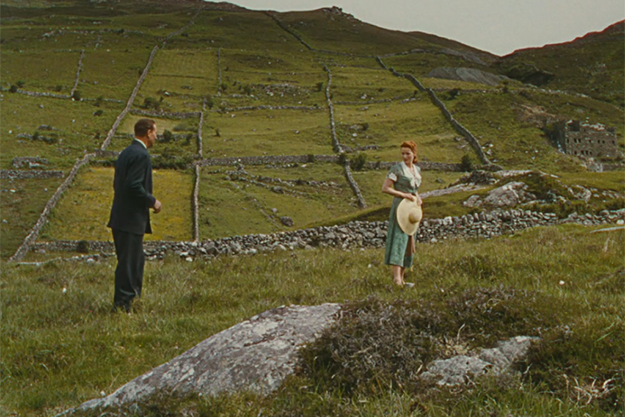
The Quiet Man
At 11, he spent several weeks with his father in rural Galway. His scrupulous biographer Joseph McBride suggests that the “extravagantly beautiful landscapes” of his best-known Ireland-set film, The Quiet Man, evolved out of that early encounter with the country’s countryside, and out of the traditional group dance the father-son pair attended on their pilgrimage’s final night. Indeed, there’s something unmistakably similar about the way Ford frames that film’s characters against the undulating hills of rural Ireland and the way he frames the cavalry troops and pilgrims that populate his Westerns against the Krazy Kat horizons of Monument Valley. But The Quiet Man was half a century away when Ford returned from that trip—and although it’s often considered Ford’s definitive hymn to Ireland and its people, it’s also something of an anomaly among his movies set in his parent’s home country.
The Informer and The Plough and the Stars, made a year apart in the mid-Thirties, are grim, moody, almost completely nocturnal reveries set during the Irish Revolutionary Period in a cramped, stifling Dublin. We are allegedly in the same country that includes The Quiet Man’s bucolic cottages and pastures, but we might as well be on the other side of the world. Both movies took inspiration from work by prominent writers associated with the late-19th-century Irish literary revival and the Abbey Theatre, founded in 1899 under the auspices of, among others, Lady Gregory, W.B. Yeats, and George Moore. Irish nationalists occasionally revolted against the theater’s productions on political grounds (Sean O’Casey’s The Plough and the Stars, the basis for Ford’s film, incited a riot on its opening night over its embittered picture of the Easter Rising), but the institution was defiantly, proudly Irish in its sensibility, its tone, and the range of its interests. Ford tried repeatedly to bring the Abbey players to Hollywood with little success, although he did manage, with The Plough and the Stars, to launch the fearsome Barry Fitzgerald on a successful American career as a character actor. One imagines that he envied them what freedom they had. When he ran into trouble filming O’Casey’s play, he must have wished it was because the story wasn’t supportive enough of the nationalist cause.
Ford adapted The Informer with his regular collaborator Dudley Nichols from a novel by Liam O’Flaherty. The two were close (they were cousins from somewhere down the line), and it was in O’Flaherty that Ford found a direct feed into the Irish political landscape of the Thirties. A tragedy centered on a dazed exile from the IRA who turns informant for immigration money he instantly wastes over the course of a long, drunken dark night of the soul, The Informer captures the peculiar mood of a country still fiercely divided over the compromise treaty that had ended the Anglo-Irish War in 1921. What’s striking about O’Flaherty’s story was the balance it struck between empathy for a traitor and faith in the cause he was foolish enough to betray.
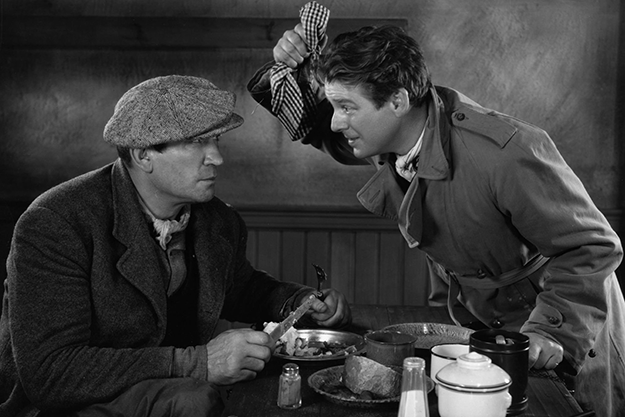
The Informer
For the lead role, Ford chose Victor McLaglen, a former boxer with a bulldozer figure and an onscreen manner of weirdly combative tenderness. McLaglen would give subtler performances for Ford, but none that were this loud, imposing, and aggressively commanding. The real interest of The Informer lies, however, in the indelible image of revolutionary Dublin it summons up. Bereaved and stranded women move somnolently through fog-shrouded streets; drunks bend over their tankards; elderly matrons teeter back and forth in rocking chairs; snatches of rebel songs, national anthems, and funeral hymns float in from sources hard to place; IRA members crouch in shadowy nooks or hold their breath behind doors.
Ford was at the height of his expressionist period when he shot The Informer, and there’s a lugubrious heaviness to several of its showier passages. Much of the movie, however, lingers oddly in studio-set streets and tenements, testing the atmosphere and coaxing out, séance-like, what Ford took to be the character of the period. He was in the precarious position of an artist interested in the texture, mood, and spirit of places and times about which the studio executives who bankrolled him had little interest. When Ford tried to explain to the chief of production at RKO, which produced both of his early Irish films, that The Plough and the Stars was supposed to be about a country’s struggle for its independence, the man was baffled; he thought, he told the director impatiently, that Ireland was already free.
Certain critics were better equipped to appreciate the texture of The Informer. (Club-footedly, one New York Times reviewer called the film “a rawly impressive picture of the Dublin underworld during the Black and Tan terror.”) So were many viewers; The Informer took a sizeable box office draw and eventually won Ford an Oscar for directing (and McLaglen one for acting). The movie’s defiant specificity—its insistence on conjuring an appropriate visual tone for this Dublin at this time—was its great asset; it was also the thing that Ford’s distrustful producers took the greatest pains to stamp out.
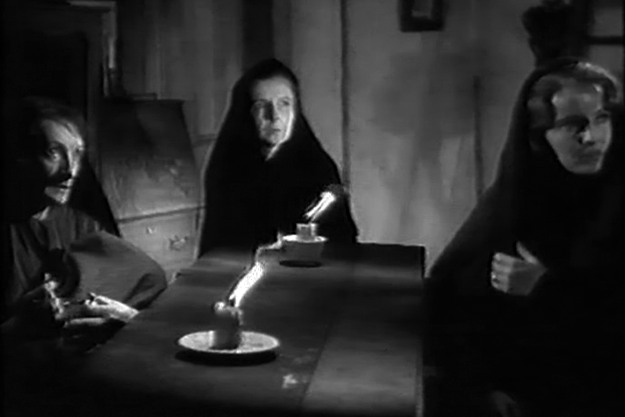
The Plough and the Stars
Ford would look still more doggedly in The Plough and the Stars for ways to imagine a revolutionary Dublin. Look, if you could miss it, at the bravura scene 15 minutes into that film in which Ford cuts repeatedly back and forth between the crowd at an IRA rally and the dignified speaker towering above them. The row of young boys lined up like first communicants (or, for that matter, like the Sons of the Pioneers in Rio Grande), clutching standards and staring hauntingly into the camera; the profiles of stern middle-aged men arranged in what looks like battle formation; the young woman kissing the cheek of (presumably) her mother to stay the older woman’s convulsed features and quavering lips—the scene moves like a series of still photographs charged with static life. In passages like this, Ford’s Dublin films come unmoored from their plots. For all their expressionistic flourishes and grandstanding theatrics, they keep opening up into portraits of people cast more or less as themselves. “For these pictures that deal with the Irish uprising,” Ford told the press around the time of the release of The Plough and the Stars,
I’ve looked up former Black-and-Tan soldiers, former rebels, former onlookers, and given them parts. It adds to the sincerity because in the mass demonstration scenes they remember their own experiences and have real tears in their eyes—and every now and then some extra will offer a suggestion that lends to the authenticity of the production. Some of them—Arthur Shields for instance—were really in the Dublin post office when it fell. They were in this pub we’ve reproduced when the call came to mobilize.
The plot of The Plough and the Stars, like that of The Informer, emerges from a deep ambivalence towards the Irish nationalist cause. Both films are about what it looks like to have to choose between the degradation of living under occupied foreign rule and the perils—both physical and moral—of attaching yourself to a righteous, violent uprising. Ford’s American audience responded to Victor McLaglen’s hysterical guilt throes. They cared, some of them, about the agony Barbara Stanwyck displays in The Plough and the Stars—in which the young, talented actress was badly miscast as a clingy young housewife—when her husband takes up arms to fight in the battle escalating under her living room window. But they were unavoidably distant from the world whose particular difficulties Ford kept underlining across the two movies. For many of them, there was something cryptic and foreign about the recent period these films were meant to evoke—although not, you sense, to the extent Ford’s producers feared. After Ford refused to shoot additional romantic flashback scenes for The Plough and the Stars between Stanwyck and the wooden, aggressively serious Preston Foster, RKO brought in an assistant director to do the job. The final cut was a deeply evocative historical re-creation, and a dramatic mess.
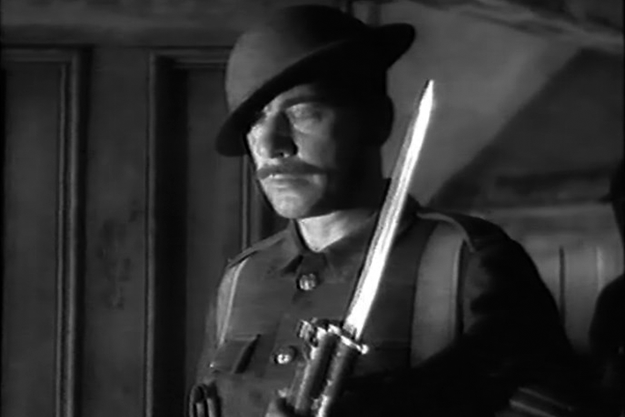
The Plow and the Stars
The Quiet Man was produced under slightly more tolerant circumstances—a risky and grudging investment by Republic Pictures, which had financed Rio Grande the previous year. Ford could well have been thinking about the disastrous outcome of his attempt at The Plough and the Stars when he chose to weave the later movie out of a lighter, brighter, more delicate and colorful fabric. But his temperament as a filmmaker had also changed in the intervening years. The anger, indignation, and fervid moral questioning that seethe on the surface of his Thirties films persist in his later movies, subtly guiding the course of their action without ever coming fully into the open. It’s important to read the first lines of the 1933 Maurice Walsh story on which the movie was based in light of the preceding two decades of revolutionary violence, and the generational curse of silence, disillusion, and suspicion that violence inspired:
Shawn Kelvin, a blithe young lad of 20, went to the States to seek his fortune. And 15 years thereafter he returned to his native Kerry, his blitheness sobered and his youth dried to the core, and whether he had made his fortune or whether he had not no one could be knowing for certain. For he was a quiet man, not given to talking about himself and the things he had done.
The tone of those first lines muffles the triumphant peal of the story’s last lines, in which Kelvin’s new wife sighs with relief over having finally been able to “make a man of him.” It’s in a similar way that Ford’s The Quiet Man acts as a kind of contrast pattern to The Informant and The Plough and the Stars—a splash of color both enlivened and complicated by those films’ darker shades.
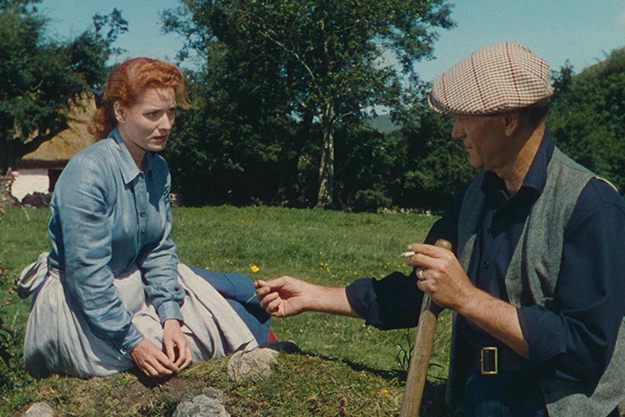
The Quiet Man
The film’s Sean—Thornton, not Kelvin, and embodied by a stiff-backed John Wayne— hears that Innisfree, the fictional Irish town in which he’s just arrived from America, is “not a haven.” The movie’s serenely gorgeous landscapes test that claim. Shot on location in County Mayo and County Galway, they’re surprisingly more idealized and fanciful than the studio backlot city blocks of, say, The Plough and the Stars. But the promise of violence is the film’s dramatic motor, the force that structures it and spurs it on. Wayne’s character, it’s soon established, is a former boxer who’s hung up his gloves after having killed an opponent in the ring, and The Quiet Man builds steadily to the moment when he has to fight again. (Famously, Ford stopped the film during a test screening moments before the start of its long, climactic fistfight—a canny strategy to convince the producers that he could go a few extra minutes over his maximum run time.) It’s the sort of narrative that could only have come from a moment when the threat and promise of violence was constantly in the air, when peace could only be accepted with skepticism or mistrust. The same could be said of the film’s humor, which—as always with Ford—can come off as brutal. You don’t easily forget the late passage in which Thornton drags his prospective wife (Maureen O’Hara) forcibly cross-country to watch him earn her hand in a fight against her brother; or the elderly woman who approaches Wayne’s character midway through that scene, offers him a branch, and tells him—with great tenderness—that she thought he could use “a stick to beat the lovely lady with.”
The whole trajectory of Ford’s cinematic relationship with Ireland plays out backwards in The Rising of the Moon (57), a three-part comedy that opens with a lingering shot of the cliffs of Galway and ends with a long passage set in the milieu of Ford’s earlier Irish films: a long, sleepless night during the Black and Tan War. It’s hard to know how the direct-to-camera addresses by Tyrone Powers that introduce the first two of the film’s three short, unrelated segments would have come off to audiences accustomed to, say, Alfred Hitchcock Presents; whatever tone they were supposed to have, they suggest just what a dismally narrow picture of Ireland Ford attributed to his viewers by the mid-Fifties. “Now as you know,” Powers lectures from what looks like a suburban doorstep, “Ireland is a quiet little island of about four million population… Of course, as we’re a quiet and peace-loving people, nothing much ever seems to happen in Ireland.” The camera, meanwhile, is gliding towards a rustic police station in County Westmeath—“for although we are a very quiet and peace-loving people,” Powers drawls, “we still have, believe it or not, police barracks.”
The running joke of The Rising of the Moon is that the film’s stories all kick the supports out from under that judgment, each time with escalating ferocity and bluntness. By the time the two caricatured English tourists at the brunt of the movie’s second segment watch a victorious cricket team marching past their stalled train and ask, laconically, whether this is “another of their revolutions,” it’s clear that the movie was never meant to be taken at its initial word. It argues, with more directness and arguably less elegance than any of Ford’s other major Irish films, against the picture of Ireland assumed by that early speech—a gross parody of what many Americans may have thought about Ireland after watching The Quiet Man. It’s as if Ford was worried, with that earlier film, about having given his audiences a falsely beatific image of the country—as if he felt the need to correct for The Quiet Man, or atone for it.
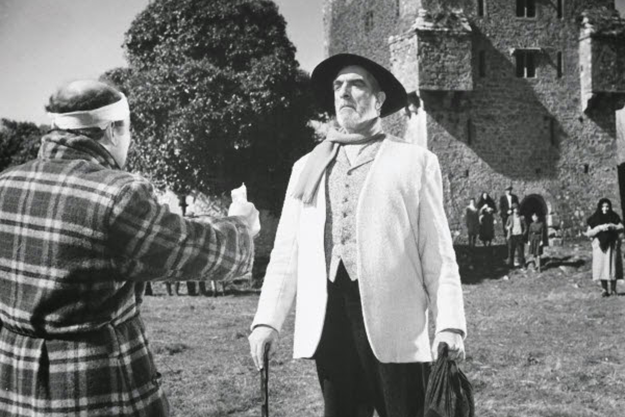
The Rising of the Moon
What completes the argument is the movie’s third segment, a dark comedy about the failed hanging of an Irish nationalist set in 1921 and adapted from a one-act play by Lady Gregory. (Both the play and Ford’s film take their title from a spectral rebel song that recurs like a motif throughout the movie.) A strange piece of filmmaking, full of lopsided shots that capture their subjects teetering on slanted, seesaw-like visual planes, The Rising of the Moon’s climactic episode can’t help but come off as a regression from a filmmaker who had already made Pilgrimage, Young Mr. Lincoln, My Darling Clementine, and The Sun Shines Bright. Whereas the movie’s first two sections show Ford working lazily, on commission, this last short finds him falling back on exaggerated stylistic flourishes, as if to compensate for having failed to find a language equal to his subject. Ford’s inability to capture the texture of revolutionary Ireland—to freeze and study individual Irish patriots at moments of acute moral crisis—to his satisfaction is a recurring theme in the story of his long engagement with the country’s troubled past. That it was a failure, few viewers but he would have recognized. When it came to filming Ireland, Ford failed like he succeeded: quietly.
The Essential John Ford continues through August 2 at the Museum of the Moving Image.



